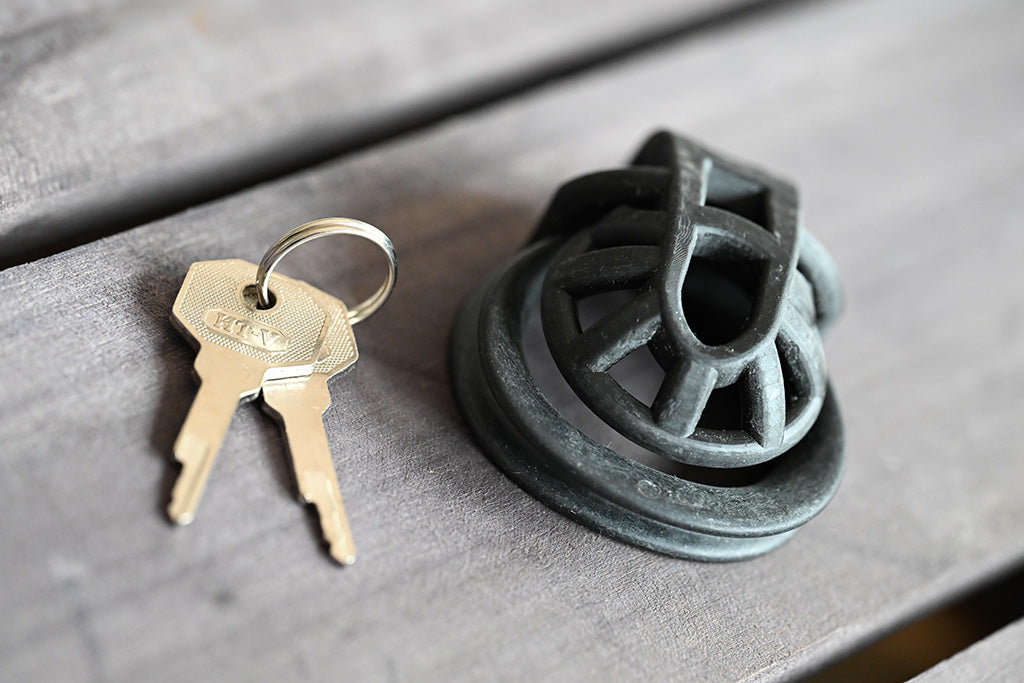
During the years we spent designing and developing our Olympus collection of 3D printed chastity devices we learnt a lot. Seriously, we lost count of how many hours we spent on that project before the launch of Hera, the first device in the range. We made plenty of changes to the cage and ring designs, endlessly tweaked the lock systems and experimented with different printing methods. But do you know what took more of our time than the rest of those challenges combined? Perfecting the surface finish.
As owners of one of the largest chastity businesses in the world (hey, we worked hard for it - let me enjoy that thought for a moment) we receive messages from designers, manufacturers and wholesalers of different cages on a weekly basis. They ask if it’s OK for them to send us samples of their latest creations so that we can then consider selling them on the website. Come on, who doesn’t love a freebie? Of course we say yes! They could be sending us the latest, greatest innovation in cock locking technology that the world has ever seen.
Has that ever happened? No.
Here’s an example of one device that we received recently:

If you’re thinking that it looks poorly made, dirty, probably isn’t safe to wear and will likely cut your cock to ribbons then you’re absolutely right on all counts.
Full disclosure; I didn’t even try putting this kit on to test the feel and fit. Mistress K has a few sadistic tendencies, but even she wouldn’t stoop so low as to make me wear this thing.
This is just one example, but it’s certainly not the only kit that we’ve been sent that looks this bad. Far from it. The surface of the parts are rough to the touch, the edges are sharp, I don’t know if it’s been 3D printed using body safe materials and, if it was dyed after printing, I have no clue if the dye is safe for skin contact either.
There’s a very good reason that these kits are available to buy on a range of websites for less than you’d pay for a coffee in London. They’re garbage. You get what you pay for. Please don’t be tempted.
At this point you might think that I’ve written this post to bad mouth our competitors in the hope that you’ll avoid their products. In a way that’s true, but I genuinely have your best interests at heart. We want everyone to have a positive chastity experience, be it solo locking or with a keyholder, regardless of where you buy your cage from.

In the interest of fairness and impartiality, I want to add that not all of the 3D printed devices that we’ve been sent were terrible. Some were actually quite good. The designs are aesthetically pleasing, the parts are reasonably smooth and the painted surfaces don’t chip if you catch them on anything. You know, like a high heel toying with the tip of your caged cock. I digress.
With all of the above in mind (the heels and teasing aside), let’s have a look at what you should look for in a poor quality chastity device that you absolutely should not use.
Visible print layers
3D printed parts are created one layer at a time during the printing process. The height between these layers is different depending on the machine that’s used to print the parts. A larger print layer height will make these layers more visible, while a smaller layer height will compact them. This will result in less visible layers. Makes sense, right?

If you can see the layers on the side of your cage or back ring it can mean a few things.
- The print layer height is too large. This can cause irritation to your skin as the rough finish rubs against you. Imagine wrapping your cage and ring in sandpaper and wearing that daily. No thanks!
- The finishing method that was used isn’t very good. A number of finishing processes including vapour smoothing, which smoothes the surface of a part by chemically “melting” the outer surface to make it more even after printing, can help to minimise print lines. It also seals the surface making it more difficult for bacteria to grow there.
The device in the example above looks like the manufacturer has tried to manually sand the edges to smooth and hide the print lines, but they've failed to seal the outer surface properly. All of the small crevices left over are a dream for bacteria and grime to build up in. Pretty grim.
Check that the lock actually fits
OK, this one might seem obvious, but it’s so annoying when it does happen. You get a new toy in the post, tip the kit out of the box and jump straight into putting it on, only to find out that the lock doesn’t fit into the device.

No, I’m not kidding. This has happened plenty of times to us. It can be caused by the accuracy of the printer being poorly calibrated or the files they use to print with haven’t been verified to ensure they’ll fit the lock barrel size.
One is annoying, the other complete stupidity.
There is a way to fix this issue if you ever encounter it. You can either use a power drill with a 6mm drill bit on it to widen the hole (I recommend clamping your kit in place to make sure you drill the hole accurately) or use a small file to open up the size of the hole. However, both of these options will strip the outer finish, which will leave areas that bacteria will set up camp in.
Sharp edges
This is more common than you’d think. A lot of the Chinese based manufacturers (not all of them) don’t care too much about the quality of their products. This is a fact. We know because we’ve spoken to them. They’re more concerned about quantity than quality.
So you receive the kit in the post that you’ve been excited about for weeks. You open the box and the edges of your cage are so sharp that it could have been wielded as a weapon in the middle ages. That’s a hard pass from me. You don’t want that thing anywhere near your most prized possession and I wouldn’t recommend that you try.
You could try smoothing the edges with a metal file or sandpaper, but why should you? Avoid.
Rough surface finish
I mentioned at the beginning of this post that getting the very best surface finish we could when we developed Hera was our biggest challenge and I’m really not kidding when I say this. It took endless trials, tweaks and experimenting with lots of different methods. Finally, after nearly pushing our production partners to breaking point, we cracked it.

Most 3D printed parts will need some post processing after printing to ensure that the surface of the parts are smoothed and sealed. Vapour smoothing does this, but most cheap kits don’t use this process as it’s not widely available. It also takes time and can be quite costly.
Some manufacturers paint their chastity kits to cover up the rough surface after they’ve had some light sanding. Is the paint they use skin safe? You’d like to think so, but I can’t guarantee that. What happens if the paint chips uncovering an unsealed surface? It’s going to rub against your skin, which could lead to abrasions and cuts.
Simply put, a rough surface will increase your risk of injury, which will require medical attention and time outside of your cage. No-one wants that.
Skin safe
Now I don’t know about you, but if I’m going to be wearing a device on my cock you better believe I want to know that it’s skin safe before doing so. Dyes that include PPD can cause allergic reactions for some people, so contact the seller before you buy or do a skin patch test before you lock it onto your cock. The last thing you need is for your caged penis to start itching or swell up (leave that for your teasing keyholder!) Our white Hera chastity kit doesn't have any dye in it, so it will be safe to wear for anyone with a PPD (paraphenylenediamine) allergy.
The same issue can happen if the materials used to print the device aren’t body safe. We’ve experimented with 3D printing in metal and, depending on the metal you print with, this has also been known to cause issues for some.
What does a high quality 3D printed chastity device look like?
I’m glad you asked, and if you didn’t ask I’m going to tell you anyway.
We launched our own Olympus collection of 3D printed cage kits back in 2023 after years of learning, development, consultation with experts in the additive manufacturing profession, prototyping, then refining our designs and the manufacturing process until we were completely satisfied with the final product. It took thousands of hours of work, but the end result speaks for itself.

This is Hera, the first cage in our exclusive collection. It’s printed using industry leading MJF (multi jet fusion) technology then vapour smoothed to achieve the ultra smooth surface finish that we spent countless hours perfecting.
The edges are smooth, the lock fits (I can’t believe I’ve had to write that but here we are), it’s body safe and the surface is sealed to significantly minimise the risk of bacteria growing on it. It’s easy to clean and it’s made of ultra lightweight and strong nylon-12.
Am I telling you all of this to boast? OK, a little, but there’s a serious reason for all of this. It’s to show you why our Hera cages are more expensive than cheaper so-called 3D printed kits.
We care about the quality and safety of our products and want you to wear a device that will enable you to lock your cock with the only real concern being when you’ll be allowed a release. We could very easily throw a design together in minutes and send it off to be printed by the cheapest manufacturer that we could find. We didn’t do that.
Instead we worked with some of the very best production partners that we could find and relentlessly bugged them (I’m not kidding) to try different things to keep improving what was already a reasonably good product. We didn’t and still don’t accept pretty good; we wanted industry leading quality, and that’s what we’ve ended up with.

So if you do take the plunge and buy a Hera cage from us (thank you in advance) know that our blood (no actual blood was spilt during the making of Hera), sweat and tears (there were definitely tears - all mine after a week of relentless teasing and denial by Mistress K) went into creating it.
We reject the vast majority of the devices that we're offered by manufacturers because we don't think it will offer you an enjoyable (and positively frustrating) chastity experience. I hope that this article has clearly demonstrated why we politely decline and why you should too.
If you own or have tried any 3D printed chastity devices and would like to share your story - good, bad or ugly, please leave a comment below so that we can have a discussion about it. Alternatively you can find us on Twitter @houseofdenial if you'd like to ping us a message.



Leave a comment